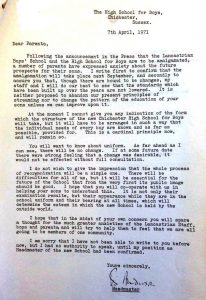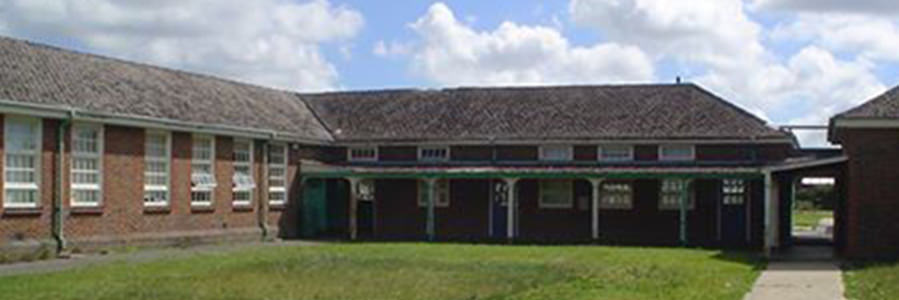 Autumn term, 1971
Autumn term, 1971
The question of whether or not secondary school education should be organised by academic ability and gender has been under debate pretty much since the end of the Second World War. This article does not join that discussion, but records how Chichester High School for Boys (The School) and the Lancastrian Boys School were merged into a single comprehensive school in the Autumn Term of 1971. As well as being an important part of the history of the School, it is also a fascinating case study on the management of change.
I was a School pupil just entering the lower sixth form at that time and my recollections put me in mind of the occasion I watched a camel race: the camels were lined up kneeling down at the start line, each with a boy mounted on its back and a man standing behind brandishing a stick. At the start, the camels received a sharp thwack and took off at great speed – several of them in the wrong direction. Bedouin spectators chased the leading pack in their pick-up trucks in a chaotic scene. The beginning of Autumn Term 1971 felt like that to my younger self. When the newly formed comprehensive school opened, there was the bare semblance of a timetable for lessons and the name of the new school had not yet been agreed. Nobody really seemed to know what was going on in the early weeks. However, order emerged as the term progressed and, from the perspective of the lower sixth form, life went on much as before. Of course, as an adult who has worked in organisations undergoing change and, I should admit, managed organizational change, I now realise that chaos in the early days is not uncommon.
Events outside Chichester
To understand events at the School and the Lancastrian it is necessary to go back in time – go back to the mid-Sixties and the government of Harold Wilson, go back to the Ted Heath government in which the up-and-coming Margaret Thatcher was the newly appointed Minister of Education, and remember that 1971 was just a few years before the Three-Day Week. The social and political climate in Great Britain was very different from today’s. After the war, there was a strong and broadly held belief that the wartime sacrifices of ordinary people should have been made to some purpose; there was a willingness to be radical in the pursuit of improvement.
In 1965, the recently appointed Labour Prime Minister Harold Wilson selected Anthony Crosland as the Secretary of State for Education and Science; under his tenure, the department issued Circular 10/65 “requesting” Local Education Authorities to begin converting secondary schools to the comprehensive system. It was a thinly veiled instruction rather than a request because HM Government would only provide funding for building new schools if they were comprehensive and at that time, demand for new schools was high to provide places for the baby boom. Susan Crosland has written that she recalls her husband saying, “If it’s the last thing I do, I’m going to destroy every ******* grammar school in England. And Wales and Northern Ireland”.
Local Education Authorities began to make and carry out plans to implement Circular 10/65. This was interrupted by the victory of the Conservative party in the 1970 general election. The new Prime Minister, Ted Heath, appointed one Margaret Thatcher as Education Secretary: she, in contrast to Crosland, opposed comprehensive education and so began a review of all the plans to abolish selective education. This sharp change of direction following the election not surprisingly resulted in uncertainty and delays – not least in Chichester – although hindsight tells us that, under Margaret Thatcher’s tenure as the minister, the proportion of secondary pupils studying at comprehensive schools rose from 32% to 62%.
Events in Chichester beyond the Kingsham Road fence
The West Sussex County Archive holds a candid anonymous note-for-file describing the run-up to 1971 (The Problems Involved in the Reorganisation of Secondary Schools in Chichester). It details how four years of silence concerning the re-organisation of education in Chichester from the County Education Department were broken in 1969 by the Director of Education, Dr. Read, who called a meeting of Heads, teachers and the teachers’ trade unions to institute a consultative planning for secondary education in Chichester. The professional view was divided, although most teachers favoured co-educational comprehensive lower and upper schools, this was opposed by the Girls High School – who wanted to retain the status quo.
As the consultation had not delivered an agreed plan, Dr. Read and his department took back control and proposed a two stage plan which they contended was cost-effective and could begin in September 1971: stage 1 was to amalgamate the two boys schools into a single-sex comprehensive school; followed by stage 2 which was to complete the initial phase of a new purpose-built school by 1975. This new school would take a mixed intake from its opening and gradually phase out the old schools. Funds for building the new school had not been approved at the time of the proposal, which itself received a mixed reception: – parent teacher associations in primary schools supported the offer of new buildings and abolition of the eleven plus exam, whilst parents of children already at the secondary schools were concerned about the possible disruption to their children’s education. Teachers’ unions were in favour of comprehensive schooling (some believing that co-education was as important as comprehensive education). On July 24th, 1970 the West Sussex County Council debated the proposals and, although some councillors were not enthusiastic (one called them ‘half-baked’), the plans went through at the local level. However, with little more than a year to go before the implementation date, objections could still be lodged at the Department of Education and the budget for stage 2 was not approved. Margaret Thatcher’s department was lobbied by Chichester stakeholders from both sides but, after further delay, approved the plan.
Events behind the Kingsham Road Fence
On March 29, 1971 the Chichester Observer announced that the High School for Boys and the Lancastrian Boys School were to amalgamate from September 1971 (changes within the girls’ schools were deferred by a year). Whilst it is likely that this decision was known by K.D. Anderson (“KD or Ken”, the existing headmaster of the Boys’ High School) and others some time before the announcement there had been a period of considerable uncertainty, which is detailed in notes from Ken to the School staff. Ken had been appointed Headmaster of the new school (the anonymous note says rather sharply. “The Head of the Boys High School is a dominant person, highly qualified and had previously been Head of a co-educational school. This man stood to gain most both in salary and status….”). That he was considered “a dominant person” comes as no surprise but I, quite wrongly, had imagined he opposed the new organization.
Ken wrote to parents on April 7th (Picture) announcing the impending change in a letter which characteristically gets one of his major preoccupations by paragraph 3 – continuity in uniform. I confess I was struck by the penultimate paragraph in which he acknowledges the greater concern felt by the staff and parents of the Lancastrian School; this must have been a difficult time for them.
On June 21 proposals for the appointments of senior staff for the new school were put to the Board of Governors and approved – these were drawn from the existing staff of the School and the Lancastrian School. There was now a little over two months to appoint the remaining teaching staff and sort out the logistics and timetables for running the new school and bringing together the Lancastrian and Kingsham wings.
John Hyland (“Sobo” – who taught Physics) was to lead the senior school in the Kingsham wing and Mr. Creed-Newton O.B.E. (“Crud’ – whose favourite anecdote was “we couldn’t make a decent cup of tea in Kenya …the altitude was too high you see, reduces the boiling point of water”) the junior school. Roger Quittenton (popular rugby-playing mathematics teacher) would be the Sixth Form Master, Mr. Russell the Head of Science and Mr. Ayling the Director of Music.
The new school opened with every little fanfare as far as I can remember.
There was a Governors Meeting on 25th October at which “The Headmaster reported orally and in detail to the Governors on the initial integration of the schools and the problems which had been encountered during an intense period of activity. The Headmaster stated that the new school was now functioning smoothly and explained fully to the Governors”.
Stewart Kempsell 1966-1973
Postscript
The current school website announces in a Merger Update “The Education Funding Agency, on behalf of the Department for Education, has approved the merger of Chichester High Schools for Boys and Girls with effect from September 2016”. Stage 2 of Dr. Read’s plan is about to be made reality – some forty five years after the original plan was announced.

